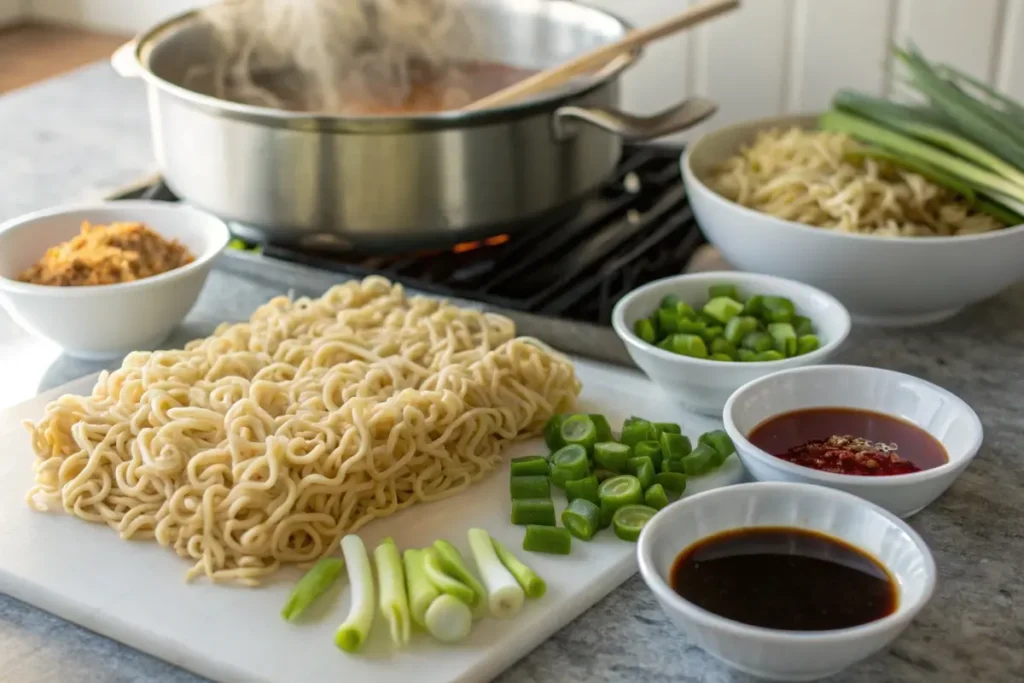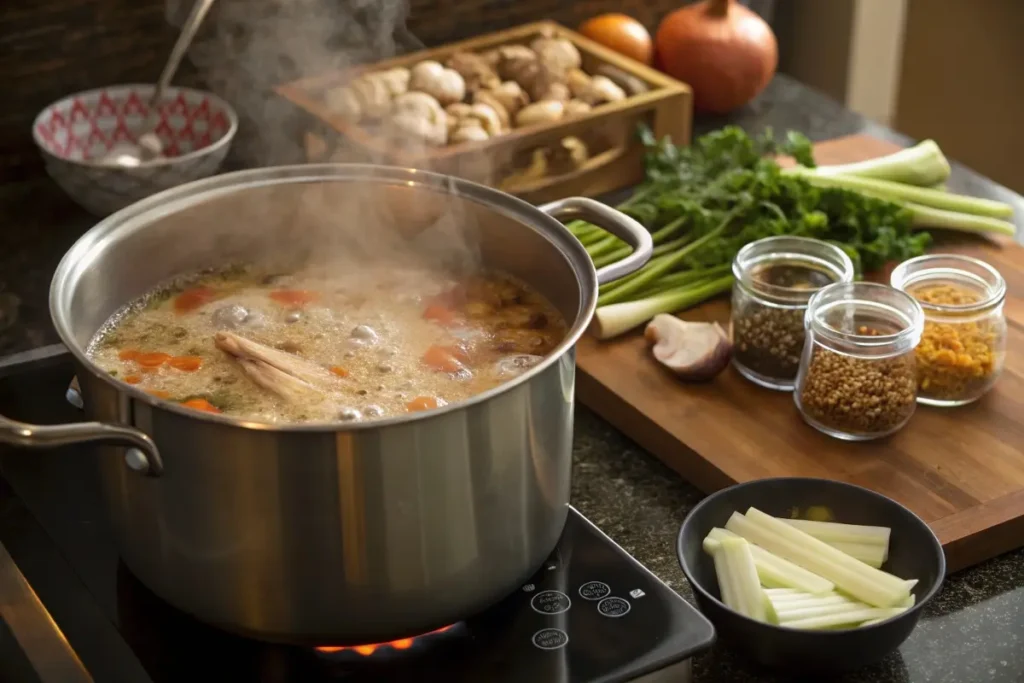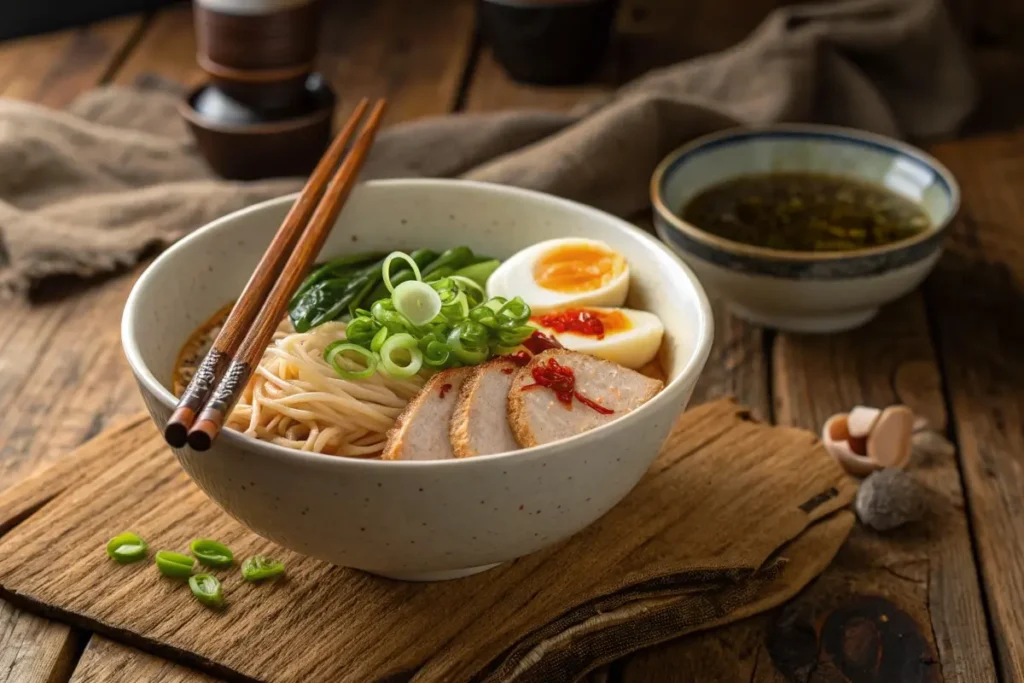Are you craving a warm, comforting meal that combines rich flavors, satisfying textures, and a touch of culinary adventure? Look no further than the ramen noodle bowl recipe, a beloved Japanese staple that has won hearts around the world. In this guide, you’ll discover how to craft a memorable bowl of ramen at home, complete with savory broth, perfectly cooked noodles, and delicious toppings. Whether you’re a dedicated foodie or a beginner in the kitchen, you’ll find valuable insights here on ingredients, techniques, and creative twists. Let’s dive into the art of ramen noodle bowl recipe and learn how to make every spoonful a celebration of flavor.

Explore more Japanese culinary inspirations to expand your repertoire and see how ramen fits into the broader context of iconic dishes.
Table of Contents
Ramen Essentials and Ingredient Selection
Few dishes are as versatile as ramen. At its core, ramen consists of four elements: broth, noodles, tare (seasoning base), and toppings. To master a ramen noodle bowl recipe, it’s essential to understand how these components work together.
The Broth Base
- Richness and Depth: Traditional broths often simmer for hours to develop a deep, savory flavor profile. You can create a ramen broth recipe using pork bones (tonkotsu), chicken bones, or a combination of dashi and miso for a lighter taste.
- Aromatics: Onion, garlic, and ginger lend robust undertones. Adding a dash of soy sauce or mirin enhances the broth’s complexity.
- Alternative Options: For a cleaner or vegetarian approach, try mushroom or kombu-based broths. These offer earthy, umami notes with fewer calories.
Noodle Selection
- Wheat-Based Noodles: Most ramen noodles use wheat flour and kansui (an alkaline agent) that gives them their signature chewy texture. If you’re keen on learning how to make ramen noodles, experiment with different flour types or purchase high-quality fresh noodles from a local market.
- Cooking Tips: Cook noodles separately in boiling water to prevent clouding the broth. Rinse quickly in warm water and transfer directly to the serving bowl.
Seasoning (Tare)
- Salt (Shio): A delicate base that highlights the broth’s natural flavors.
- Soy Sauce (Shoyu): Adds a tangy, fermented depth.
- Miso: Provides a creamy texture and sweet, earthy undertone.
Toppings and Garnishes
- Protein: Sliced chashu pork, marinated chicken, tofu, or seafood like shrimp.
- Eggs: Soft-boiled eggs marinated in soy sauce (ajitsuke tamago) bring a velvety richness.
- Vegetables: Corn kernels, bamboo shoots (menma), bean sprouts, and scallions are popular.
- Finishers: A drizzle of sesame oil, chili oil, or black garlic oil can transform the flavor profile.

When selecting ingredients, remember that fresh, high-quality components can elevate even the most simple ramen recipes into an extraordinary feast. If you’re looking to complement your meal, consider pairing your ramen with a side of Japanese Chicken Fried Rice for a hearty, satisfying dinner.
Crafting Your Homemade Ramen Broth
One of the most crucial steps in any ramen noodle bowl recipe is perfecting the broth. A well-structured broth offers layers of flavors that gradually reveal themselves with each sip. From the subtle sweetness of caramelized onions to the robust meatiness of pork bones or chicken stock, there’s a world of taste ready to be explored.
Step-by-Step Broth Preparation
- Roast or Blanch Bones:
- For pork or chicken-based broths, blanch bones in boiling water for a few minutes to remove impurities.
- Rinse thoroughly, then roast them in a preheated oven at 400°F (200°C) until they acquire a golden-brown hue.
- Simmer Low and Slow:
- Transfer roasted bones to a large stockpot, add water, onions, garlic, ginger, and optional vegetables (e.g., carrots).
- Simmer on low heat for several hours, skimming off excess fat or foam.
- Patience is key here: the longer the simmer, the deeper the flavor.
- Enhance with Seasonings:
- After straining the broth, whisk in your chosen tare: soy sauce for shoyu ramen, miso for miso ramen, or a blend of both.
- A hint of salt or mirin can brighten the overall taste.
- Taste and Adjust:
- Sample your broth periodically, adjusting salt levels or adding a touch of umami boosters like kombu or dried shiitake.
Combining Broth, Noodles, and Toppings
- Assembly: Arrange cooked noodles in the bowl first, then ladle in hot broth.
- Layering: Add proteins like chashu or marinated chicken, soft-boiled eggs, and vegetables.
- Finishing Touches: Drizzle toasted sesame oil or chili oil for added fragrance.

If you appreciate robust flavors and want to explore additional Japanese specialties, check out the bold spices in a Japanese Curry Recipe One Piece. This curry can serve as an excellent companion dish to offset the subtlety of ramen’s broth.
Exploring Ramen Variations
Ramen is incredibly diverse. From broth styles to toppings, you can adapt any ramen noodle bowl recipe to suit your preferences. Below are some popular variations to inspire your culinary creativity.
Tonkotsu Ramen
- Key Ingredient: Pork bones, simmered for 12+ hours until the broth becomes creamy and opaque.
- Flavor Profile: Rich, fatty, and intensely savory. Often topped with chashu, soft-boiled eggs, and wood ear mushrooms.
Shoyu Ramen
- Key Ingredient: Chicken or pork stock enhanced with soy sauce.
- Flavor Profile: Balanced and mildly salty, with a clear, brownish broth.
Shio Ramen
- Key Ingredient: Light chicken or seafood broth seasoned with salt.
- Flavor Profile: Delicate and subtle, allowing the natural flavors of the ingredients to shine.
Miso Ramen
- Key Ingredient: Fermented miso paste (white or red) mixed into a chicken or dashi stock.
- Flavor Profile: Creamy, nutty, and slightly sweet. Perfect with corn, butter, and bean sprouts.
Spicy Ramen
- Key Ingredient: Chili oil, hot peppers, or spicy miso.
- Flavor Profile: Bold heat balanced by savory broth. Customize the spice level to your taste.
Incorporating Homemade Noodles
If you’re exploring how to make ramen noodles from scratch, keep in mind:
- Flour Selection: High-gluten flour provides the best chewiness.
- Kneading: Proper kneading ensures a springy texture.
- Resting Period: Let the dough rest before rolling and cutting.
For an even simpler approach, consider simple ramen recipes that use store-bought noodles but homemade broth. This hybrid method saves time without sacrificing flavor. Additionally, a classic ramen soup variation can be enriched with a spoonful of spicy chili paste or a pad of butter for a creamier finish.
If you’d like a plant-based twist, you can also find inspiration in Japanese Vegan Recipes to adapt your ramen with tofu, mushrooms, and vibrant vegetables.
Elevating Your Ramen Experience
Once you’ve mastered the fundamental techniques, there are numerous ways to elevate your ramen to culinary heights.
Garnishing with Creativity
- Flavored Oils: Black garlic oil, known as “mayu,” is made by cooking garlic until it’s nearly burnt, then blending it with sesame oil. A drizzle on your ramen noodle bowl recipe adds a smoky, intense aroma.
- Special Toppings: Nori strips, pickled ginger, kimchi, or toasted sesame seeds.
- Texture Contrasts: Add crispy fried onions, tempura flakes (tenkasu), or dried seaweed for a fun crunch.
Pairing Sides
- Gyoza (Potstickers): Pan-fried dumplings with minced pork, cabbage, and aromatic seasonings.
- Takoyaki (Octopus Balls): A popular street food that complements ramen’s savory profile.
- Side Salads: A light cucumber salad or seaweed salad for a refreshing contrast.
Presentation Matters
- Bowls and Utensils: Use deep, wide bowls to showcase colorful toppings. Chopsticks and a ramen spoon are not just traditional but enhance the overall dining experience.
- Ambiance: Dimming lights, soft music, or even setting the table with Japanese-themed placemats can make your ramen dinner feel extra special.
If you’re seeking even more recipe inspiration, take a look at this Noodles Japanese Pan Noodles Recipe. It offers a stir-fried alternative to the classic ramen soup, showing just how versatile noodles can be.
History and Context
Ramen’s roots trace back centuries, blending Chinese noodle traditions with Japanese culinary innovation. Although noodles were introduced to Japan from China, the local population adapted the concept to their tastes, resulting in a dish that has become uniquely Japanese over time. The modern ramen boom took hold after World War II when wheat flour became more accessible. Street vendors across Japan popularized quick, hearty bowls of noodles that satisfied both hunger and taste buds.
By the late 20th century, ramen shops (or “ramen-ya”) had sprung up in nearly every corner of the country, each region boasting its signature style. From the soy sauce–based bowls of Tokyo to the pork bone–rich tonkotsu of Kyushu, ramen evolved into an art form that exemplifies regional pride and creativity.
Today, ramen is not just fast food—it’s a cultural phenomenon. Michelin-starred ramen shops exist alongside humble neighborhood stands. Internationally, people flock to trendy ramen bars or craft homemade ramen in their kitchens. This global fascination with ramen can be attributed to its adaptability: it can be as simple or as elaborate as you wish, reflecting each cook’s personality. In many ways, a single ramen noodle bowl recipe is a microcosm of Japanese cuisine’s dedication to balance, flavor, and artistry. The dish’s journey from Chinese street food to Japanese culinary icon underscores the power of cross-cultural exchange and continuous evolution.
Practical Examples and Use Cases
Home Gatherings and Ramen Parties
Hosting a ramen night can be a fun way to gather friends or family around the table. Prepare the broth in advance and set up a DIY station where guests choose from various noodles, proteins, and toppings. This interactive approach lets everyone customize their bowl, catering to different tastes and dietary restrictions. Include vegetable-forward options like bok choy or shiitake mushrooms for vegetarian guests.
Meal Prep for Busy Schedules
For those with packed weekday routines, ramen can be meal-prepped with a bit of planning:
- Broth Storage: Freeze broth in individual portions.
- Quick Proteins: Keep cooked chicken or tofu on hand.
- Microwave-Friendly: Reheat the broth, cook noodles quickly, and assemble in minutes.
Culinary Exploration
Ramen offers a fantastic gateway to Japanese cuisine. Experiment with fermentation by making homemade kimchi as a spicy topping, or try your hand at marinating eggs with miso and soy sauce for extra flavor. Pair your bowl with a sweet ending from Traditional Japanese Desserts to complete the authentic experience.
FAQs about ramen noodle bowl recipe
Below are some commonly asked questions about crafting a delicious ramen noodle bowl recipe. These insights address queries that frequently arise among both novices and ramen aficionados.
1. What can I put in a bowl of ramen?
You can put almost anything in ramen! Traditional toppings include sliced pork (chashu), soft-boiled eggs, and vegetables like bamboo shoots or bean sprouts. Feel free to experiment with tofu, fish, kimchi, or even cheese for a creative twist.
2. How to make your own ramen bowl?
Start by choosing a broth (e.g., pork, chicken, or vegetable). Cook noodles separately, then ladle hot broth into a bowl containing the noodles. Add proteins and vegetables, and finish with flavorful garnishes like green onions, nori, or sesame seeds.
3. What is in a typical ramen bowl?
A typical bowl features four components: noodles, broth, tare (seasoning base), and toppings. Broth can be tonkotsu (pork bone), shoyu (soy sauce), shio (salt), or miso-based. Common toppings include marinated eggs, chashu pork, scallions, and seaweed.
4. What are the 4 components that make up a traditional ramen bowl?
These four components are broth, noodles, tare (flavor concentrate), and toppings. Each element plays a vital role, from the depth of the broth to the texture of the noodles and the finishing layer of toppings.
5. Can I use instant noodles for homemade ramen?
Yes, you can use instant noodles as a shortcut, especially if you have a flavorful homemade broth. While fresh noodles provide a more authentic texture, instant noodles can work in a pinch without compromising the essence of a cozy ramen meal.

Conclusion
A steaming bowl of ramen is more than just comfort food—it’s a culinary experience that brings together history, craftsmanship, and creativity. By experimenting with broths, noodles, and toppings, you can tailor a ramen noodle bowl recipe that suits your palate perfectly. Whether you opt for a rich tonkotsu broth or a light shio blend, the possibilities are as endless as they are delicious. Don’t be afraid to try new ingredients or cooking methods to keep expanding your ramen repertoire.

If you’re curious to try more inventive Japanese dishes, don’t miss this Japanese Scallop Recipe for a luxurious yet accessible seafood option. Keep exploring, cooking, and sharing your creations with loved ones—because every bowl of ramen tells a unique story.SEO-Friendly Metadata
Enjoy your cooking journey, and may every slurp be a delight!
